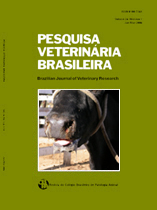 |
|
|
|
Year 2007 - Volume 27, Number 07
|

|
Estudo histológico, imuno-histoquímico e ultra-estrutural das lesões induzidas experimentalmente por Ramaria flavo-brunnescens (Clavariaceae) em bovinos, p.269-276
|
ABSTRACT.- Schons S.V., Kommers G.D., Pereira G.M., Raffi M.B. & Schild A.L. 2007. [Microscopic, immunohistochemical, and ultra-structural study of the lesions experimentaly induced by Ramaria flavo-brunnescens (Clavariaceae) in cattle.] Estudo histológico, imuno-histoquímico e ultra-estrutural das lesões induzidas experimentalmente por Ramaria flavo-brunnescens (Clavariaceae) em bovinos. Pesquisa Veterinária Brasileira 27(7):269-276. Laboratório Regional de Diagnóstico, Universidade Federal de Pelotas, Campus Universitário s/n, Pelotas, RS 96010-900, Brazil. E-mail: alschild@terra.com.br
The objective of this study was to investigate the pathogenesis of the lesions observed in cattle experimentally poisoned by Ramaria flavo-brunnescens. The mushroom was given to three 9 to10-month-old Jersey calves immediately after harvesting. Daily doses were around 20g/kg of body weight during 7 (Calf 1) or 13 days (Calves 2-3), and the total doses of mushroom given were 140, 268, and 261g/kg of body weight, respectively. One calf (Calf 4) with same age and breed was used as control. Clinical signs were characterized by prostration, anorexia, hyperemia of oral mucosa, and loosening of long hairs of the tail tip under mild traction. The calves were submitted to euthanasia and necropsied on days 8 (Calf 1) and 15 (Calves 2-4) after the beginning of the experiment. Microscopically, there was smoothness of dorsal epithelium of tongue with absence of filiform papillae, vacuolation of keratinocytes, and loosening of the keratin layer. In the hooves, there was vacuolation and irregular keratinization of the laminar epidermis and hyperplasia of keratinocytes. Hyperkeratosis, vacuolation of the external root sheath, thickening of tricholemal keratin, and inflammatory infiltration around hair follicles were observed on the skin of the tail tip. Immunohistochemical results with anti-pancytoceratin and anti-Ki67 (cell proliferation marker) antibodies showed no differences between the tongue dorsal epithelium of the control and experimental calves. Ultrastructural study demonstrated decrease in tonofilaments and increased intercellular spaces of the spinous layer of the tongue dorsal epithelium. The results of this study favor the hypothesis of an interference with the epithelial keratinization mechanisms by the toxic principles of Ramaria flavo-brunnescens. |
| |
|
|
| |
|
 |